Kabardino-Balkarien |
|
|
|
| Übersicht – Contents: | |
Diese Seite ist Teil des Projektes
Kabardino-Balkarien |
|
|
|
| Übersicht – Contents: | |
Flagge – Flag: |
|
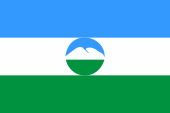 |
Nationalflagge – national flag, Seitenverhältnis = 2:3, Quelle/Source, nach/by: Flags of the World |
inoffizielle Flaggen – unofficial Flags: |
|
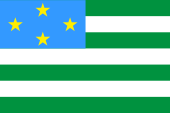 |
Kabardien/Kabardia, Nationalflagge der Kabardiner – national flag of the Kabardians, Quelle/Source, nach/by: Flags of the World |
 |
Balkarien/Balkaria, Nationalflagge der Balkaren – national flag of the Balkars, Quelle/Source, nach/by: Flags of the World |
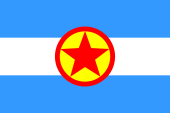 |
Nationalflagge der Balkaren – national flag of the Balkars, Variante – variant, Quelle/Source, nach/by: Flags of the World |
historische Flaggen – historical Flags: |
|
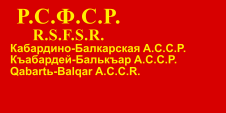 |
1937–1938, Flagge der Autonomen Sowjetrepublik – flag of the autonomous soviet republic, Seitenverhältnis – ratio = 1:2, Quelle/Source, nach/by: World Statesmen |
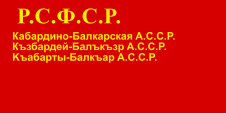 |
1938–1944, Flagge der Autonomen Sowjetrepublik – flag of the autonomous soviet republic, Seitenverhältnis – ratio = 1:2, Quelle/Source, nach/by: World Statesmen |
 |
1942–1945, Flagge Nordkaukasische und Gebirgs-Kaukasische Legion in der Deutschen Wehrmacht – flag of the North Caucasian and Mountain Caucasian Legion in the German Wehrmacht, Seitenverhältnis – ratio = 1:2, Quelle/Source nach/by: Wikipedia (EN) |
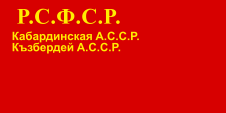 |
1945–1954, Flagge der Autonomen Sowjetrepublik – flag of the autonomous soviet republic, Seitenverhältnis – ratio = 1:2, Quelle/Source, nach/by: World Statesmen |
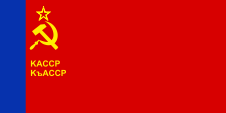 |
1954–1957, Flagge der Autonomen Sowjetrepublik – flag of the autonomous soviet republic, Seitenverhältnis – ratio = 1:2, Quelle/Source, nach/by: World Statesmen |
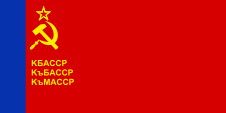 |
1957–1978, Flagge der Autonomen Sowjetrepublik – flag of the autonomous soviet republic, Seitenverhältnis – ratio = 1:2, Quelle/Source, nach/by: World Statesmen |
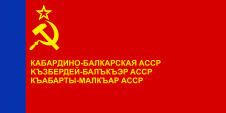 |
1978–1992, Flagge der Autonomen Sowjetrepublik – flag of the autonomous soviet republic, Seitenverhältnis – ratio = 1:2, Quelle/Source, nach/by: World Statesmen |
|
siehe auch – look also: Flaggengeschichte der Sowjetrepubliken der UdSSR – flag history of the soviet republics of the USSR |
|
|
|
|
Bedeutung/Ursprung der Flagge – Meaning/Origin of the Flag: |
|
| Die Flagge von Kabardino-Balkarien vereinigt die Farben Blau, Weiß und Grün, welche jeweils Bestandteile der inoffiziellen Flaggen von Kabardien und Balkarien sind. In der Mitte das Staatssymbol, welches die Silhouette des 5.642 Meter hohen Berges Elbrus zeigt. | The flag of Kabardino-Balkaria combines the colours blue, white and green, which are components in the unofficial flags of Kabardia and Balkaria. In the middle the symbol of the state, which shows the silhouette of the 5.642 meters high Elbrus Mountain. |
| Das Blau steht für den Himmel, das Weiß für die schneebedeckten Berge des Kaukasus und das Grün für die Felder des Landes. | Blue represents the sky, white stands for the snow-capped mountains of the Caucasus and green stands for the fields of the country. |
| Die inoffizielle Flagge von Kabardien ähnelt von der Gestaltung her sehr der Flagge von Abchasien. Die Kombination der grün-weißen Streifen soll daher offenber die Toleranz der kaukasischen Völker ausdrücken. Über die Bedeutung der vier Sterne ist bisher nichts bekannt. | The
unofficial flag of Kabardia corresponds in the designing to the flag of
Abkhasia. The combination of the green and white stripes should in this way
possibly express the tolerance of the Kaukasian peoples. About the meaning of the four stars is still nothing known. |
| Die inoffizielle Flagge Balkariens zeigt waagerecht gestreift die Farben Blau, Weiß und Blau mit einem fünfzackigen roten Stern auf einer goldenen Scheibe in der Mitte. Eine andere Variante zeigt auf blauem Grund und zwischen zwei weißen waagerechten weißen Streifen die weiße Silhouette des Berges Elbrus. | The
unofficial flag of Balkaria shows horizontally striped the colours blue,
white and blue with a five-pointed red star on a golden disc in the middle. An other variant shows on blue ground and between two horizontal white stripes the silhouette of the Elbrus Mountain in white. |
| Die Flaggen, die zu Sowjet-Zeiten verwendet wurden, entsprachen alle dem immer gleichen Schema, wie es für Sowjetische Autonome Republiken vorgesehen war: Zwischen 1923 und 1937 oft nur ein einfabiges rotes Flaggentuch mit einer goldenen Inschrift, die den Landesnamen zeigte. Manchmal nur als Abkürzung, manchmal mit vollem Namen, manchmal nur in Russisch oder auch mehrsprachig. Ab etwa 1937 wurden manchmal noch Hammer, Sichel und Stern ergänzt. Ab etwa der Mitte der 50-er Jahre wurden mehrfarbige Flaggen für die Republiken der Sowjetunion eingeführt, deren Strickmuster die untergeordneten Autonomen Sowjetrepubliken zu übernehmen hatten. |
The flags, which were used in the Soviet era corresponded all to the same pattern as it was intended for the Soviet Autonomous Republics:
Between 1923 and 1937 frequently only a single-coloured red bunting with a golden inscription, showing the name of the country. Sometimes only as a shortcut, sometimes the full name, sometimes only in Russian or even multilingual. From about 1937 hammer, sickle and star were sometimes added. From about the mid-50s multicolored flags were introduced for the republics of the Soviet Union, whose knitting patterns had to be taken over by the subordinated autonomous Soviet republics. |
| Quelle/Source: Flaggen Enzyklopädie, Volker Preuß | |
Wappen – Coat of Arms: |
|
 |
Wappen von Kabardino-Balkarien – coat of arms of Kabardino-Balkaria, Quelle/Source: Russiatrek |
Landkarten – Maps: |
geographische Lage in Russland – geographical position within Russia: |
Landkarte des Landes – map of the country: |
Zahlen und Fakten – Numbers and Facts: |
|
|
|
|
|
|
|
|
|
|
|
|
|
|
|
|
|
|
|
|
Geschichte: |
| 1825–1858 · russische Eroberung 1921 · Errichtung der Sowjetdiktatur, Errichtung des Autonomen Gebietes der Kabardiner und des Nationalen Kreises der Balkaren 1936 · Errichtung des Autonomen Bezirks (Oblast) der Kabardiner und Balkaren durch Zusammenschluss des Autonomen Gebietes der Kabardiner mit dem Nationalen Kreis der Balkaren 1943–1944 · Deportation der Balkaren nach Sibirien 1957 · Rückkehr der Überlebenden 1991 · Proklamation der Autonomen Republik Kabardino-Balkarien 31.12.1991 · die Sowjetunion löst sich auf, die Verfassung der Russischen Sozialistischen Föderativen Sowjetrepublik (RSFSR, Russland), ein ehemaliger Teilstaat der Sowjetunion bleibt vorerst in Kraft 1992 · Proklamation der Republik Kabardino-Balkarien 25.12.1993 · eine neue Verfassung für Russland (Russische Föderation) tritt in Kraft, das Verhältnis zu den Gliedern der Föderation wird damit neu geregelt |
History: |
| 1825–1858 · conquest by Russia 1921 · establishment of the Soviet Dictatorship, establishment of the Autonomous Region of the Kabardinians and the National District of the Balkarians 1936 · establishment of the Autonomous District (Oblast) of the Kabardinians and Balkarians by unification of the Autonomous Region of the Kabardinians and the National District of the Balkarians 1943–1944 · deportation of the Balkarians to Sibiria 1957 · return of the survivors 1991 · proclamation of the Autonomous Republic of Kabardino-Balkaria 31st of December in 1991 · the Soviet Union dissolves, the constitution of the Russian Socialist Federative Soviet Republic (RSFSR, Russia), a former substate of the Soviet Union, remains in force for the time being 1992 · proclamation of the Republic of Kabardino-Balkaria 25th of December in 1993 · a new constitution for Russia (Russian Federation) comes into force, and the relationships with the members of the federation is re-regulated in this way |
| Quelle/Source: Atlas zur Geschichte, World Statesmen, Russiatrek, Die Völker der Erde |